Menu

Did you know the UK plans to match EU funding up to 2020 post-Brexit? This shows big changes are happening in UK farming’s green policies. The UK will soon set its own farming rules. It aims to make farming greener and more sustainable.
Brexit has made the UK rethink its farming practices. It’s moving from the EU’s norms to new ones that care for the environment and sustainability. This change supports a plan by the Game & Wildlife Conservation Trust for less red tape and more voluntary programmes.
This is in line with the government’s goal to go carbon neutral. At first, Brexit brought financial worry and changes in the pound’s value. But fear not, as UK farmers’ EU funding is secure until 2020. The UK now rewards eco-friendly farming efforts and works on reducing floods.
Now, the UK is keen on fostering biodiversity and sustainable farming. This makes UK farming stand out globally. The main focus? New rules that champion green farming, aiming for a zero-carbon future and strong farming for the long run.
Leaving the EU means big changes for UK farming. The UK used to spend a lot of EU money on the Common Agricultural Policy (CAP). Now, it’s making a new plan to help the environment and keep farming sustainable. UK farmers are finding it tough to compete with those in the EU. EU farmers still get big CAP payments.
After Brexit, UK farm exports to the EU fell a lot. The amount of money available for UK farming support is also dropping, especially after considering inflation. Each part of the UK has its own farming policy now. This is because Scotland, Wales, and Northern Ireland have different views and methods.
In England, there’s a new farming plan that offers less money but more rules and costs. Scotland is focusing on producing top-quality food, looking after the environment, and fighting climate change. Meanwhile, Northern Ireland puts more weight on making food rather than environmental issues. Northern Ireland stays close to EU agriculture laws, thanks to Article 13(3) of the Protocol.
In the UK, England and Wales are stopping direct payments to farmers. But, Scotland and Northern Ireland plan to keep giving them. This shows a wider argument between wanting to protect local markets and wanting more open trade.
“The move from the CAP to UK-focused plans has risks and rewards for the countryside and nature,” an expert explains.
Going forward, the UK is taking old EU farming laws and making them UK laws. This will keep things running smoothly at first. Yet, the plan is to change them to fit the UK’s farming and environmental needs better. Post-Brexit farming changes will spark important talks on where UK farming policies are headed.
The UK leaving the Common Agricultural Policy (CAP) is changing UK farming. CAP previously looked at producing more food. Now, it aims to make food better and greener. Yet, the effects of Brexit on UK farms’ environment are clearer with new rules.
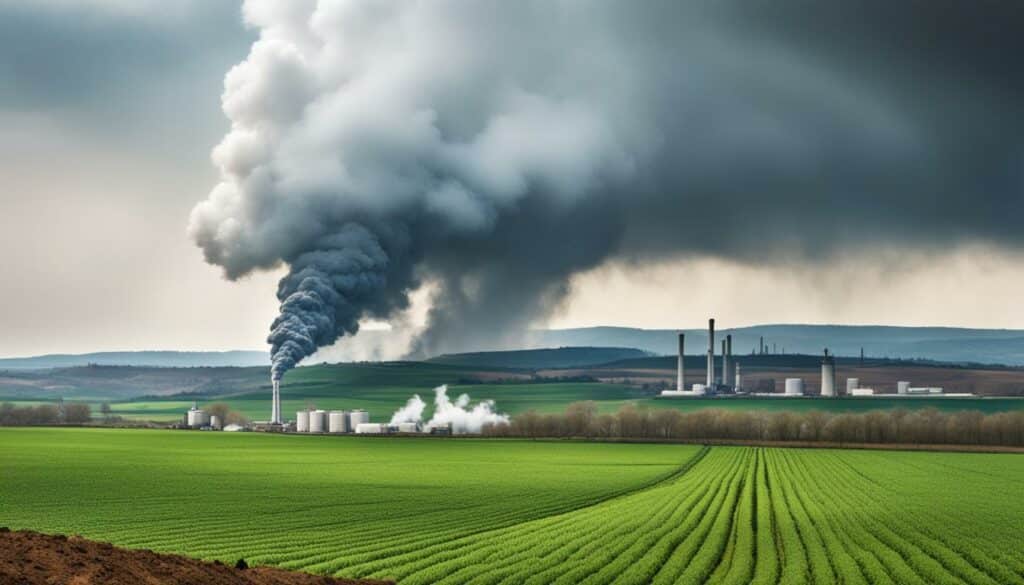
CAP was set up to help farming all over Europe grow and keep the market steady. But, it didn’t always help small farms. In areas where farming is harder, like with cattle and sheep, incomes dropped. This made many people ask for CAP to change.
CAP started moving to help the environment better. But, it made things more complex. This made selling to the EU harder and more expensive. For example, health certificates for exports cost £60 million more in 2021.
After leaving the EU, the UK made its own farming rules. It introduced new ways aims at helping the countryside and sustainable farming. Direct payments will end by 2028, changing how farmers get support.
Suddenly, more money is going to help the environment. In hard-farming areas, incomes of cattle and sheep farmers jumped 32% to £29,900. More farmers are joining with a 90% increase, happy to support green farming.
But, leaving CAP has already caused some UK farmers to earn less. By 2024, they could lose 50% of their EU help. This makes it harder as EU farmers still get Big support. With less money around, times are tough.
The UK’s new farming policy wants to learn from past reviews to improve nature and farm lands. The link between making food and caring for the environment is very tricky. But, it’s key for both sides to do well.
| Aspect | Pre-Brexit | Post-Brexit |
|---|---|---|
| Agricultural Income in Less Favoured Areas | £13,000 (2017) | £29,900 (2020-2021, 32% increase) |
| Export Health Certificates Cost | N/A | £60m (2021) |
| Countryside Stewardship Scheme Enrolment | Pre-Brexit Levels | 32,000 Farmers (90% increase post-Brexit) |
| Reduction in Farm Incomes | N/A | 20% Reduction Expected |
| EU Subsidy Withdrawal by 2024 | N/A | 50% Expected |
The UK government is dedicated to its 25 Year Environment Plan. It aims to improve and protect our natural spaces. Led by the Department of Environment, Food & Rural Affairs (Defra), this strategy will boost environmental quality for the next 25 years.
This approach is critical as the UK shapes its agricultural practices after Brexit. It calls for new and holistic ways of caring for our land.
The plan’s start was delayed by Brexit. This led to a special UK focus on environmental issues. Now, we are working on aligning our agricultural plans with long-term environmental goals.
Many important aims are part of this plan. These include making air and water cleaner. It also wants to save public forests and oceans.
This plan wants to get people closer to nature. It focuses on stopping species from disappearing. For instance, it aims to save 95% of wildflower meadows that have been lost.
There are also exciting new projects happening. They aim to fight environmental issues and build a better future after Brexit. These projects show how crucial nature is for our life and wellbeing.
After Brexit, UK farming is changing a lot. It’s moving away from the EU’s rules and towards our needs. New farming rules are being made to protect the environment.
Farmers are being asked to use fewer pesticides and manage water better. This is because farming often pollutes water. To help, there may be a Pesticide Tax to encourage less use.
The plan is also about paying farmers to improve nature. It highlights the benefits of healthier soil and clean water for everyone. This way, farms can be both profitable and good for the environment.
We’re looking towards the future with a focus on UK-specific solutions. This includes setting high goals for our environment. Groups like ClientEarth are listening to what the public wants and making sure plans are solid.
The UK countryside is seeing big changes due to Brexit. It’s moving away from the Common Agricultural Policy (CAP). This change means rules for farming are being redefined. The UK is now focused on being productive while keeping its beautiful landscapes safe.
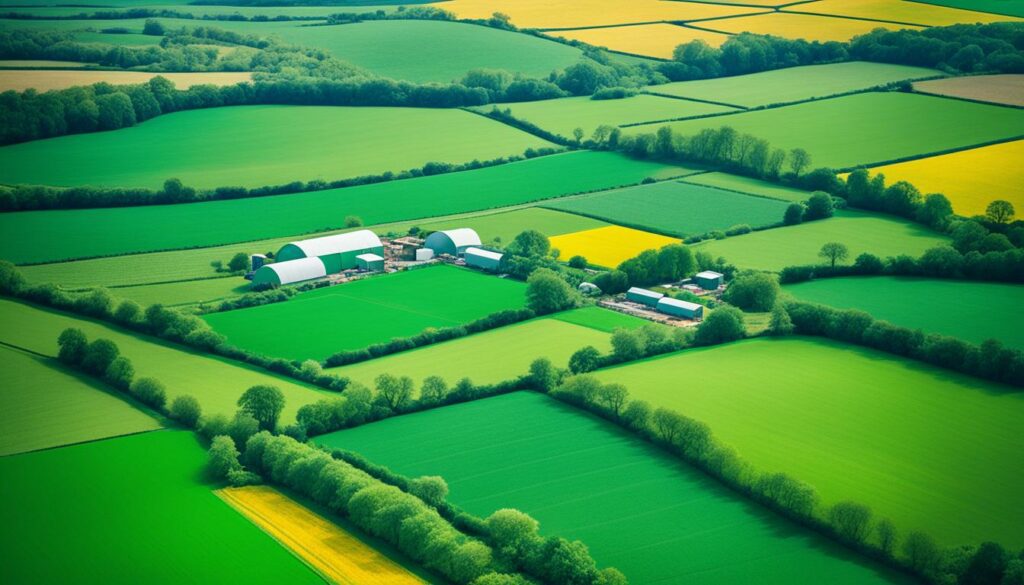
Leaving the CAP brings both good and bad for UK farmers. It’s hard and expensive to set up new policies to replace the CAP’s. The money for farming help is also going down because of inflation.
But, not all parts of the UK are handling this the same way. England and Wales are stopping direct payments to farmers. Yet, Scotland and Northern Ireland will keep some kind of payment going.
The differences between UK and EU farm rules are clear after Brexit.
Sally Davies, the UK’s former chief medical officer, worries about too many antibiotics being used. This can make superbugs that are hard to fight off. While the EU has strict rules on using antibiotics, the UK’s rules seem more relaxed. This has brought some criticism.
Scotland, Wales, and Northern Ireland each focus on different things since Brexit.
The EU Protocol keeps Northern Ireland following EU laws. This could mean big differences in farming rules across the UK.
| Region | Policy Focus |
|---|---|
| England and Wales | Phased out direct payments |
| Scotland and Northern Ireland | Retain direct payments |
| Northern Ireland | EU law continues to apply |
So, Brexit gives the UK a chance to make its own rules. But it also shows how complicated managing countryside rules can be. It requires a careful balance to protect the environment and keep the economy strong.
The UK has created the Foundation Scheme within its new agricultural plans. This scheme aims to get farmers involved and caring for ecosystems. It outlines rules to make sure farming is done in a good way for the environment.
Engaging in this scheme is up to the farmers. They can join if they want to help the environment. Each year, they sign up to do their part. This gives them the chance to look ahead and plan what they want to do. They must follow the law and farm well, making sure they protect the land while also being productive.
Hardship funding is included for areas that find farming difficult. This help is aimed at making it a bit easier for them. It means they can do things to improve, even if their land is tough to work on.
The big aim is to get all farmers to follow the rules and care for the land better. By 2028, farming should be good for people’s health locally and abroad, all without relying on subsidies.
| Year | Key Change | Impact |
|---|---|---|
| 2021 | Start of agricultural transition period | Reduction in untargeted Direct Payments |
| 2024 | Streamlined application process | 39,000 farmers participating in environmental schemes |
| 2027 | End of agricultural transition period | Universal compliance and widespread participation in environmental schemes |
| 2028 | Economic sustainability goal | Profitable, subsidy-free agricultural sector |
After Brexit, the UK is working on universally accessible agricultural programmes for all farmers, no matter their size. These plans aim to not only help the economy but also protect the environment. They show a new direction for UK farming.
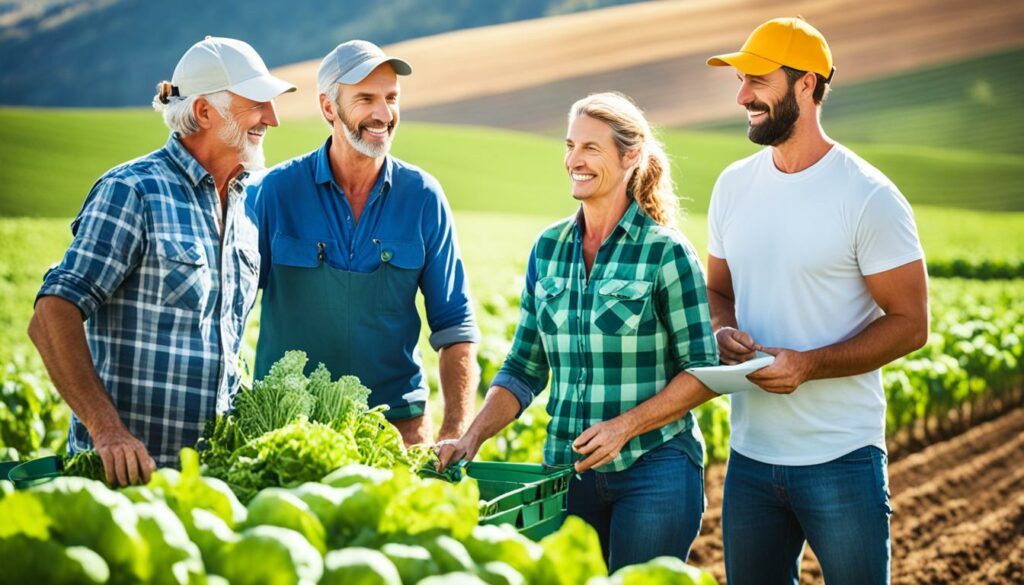
The end of the Common Agricultural Policy (CAP) means new schemes like the Sustainable Farming Incentive are important. This new plan puts effort into better soil, cleaner water, and controlling pests without harmful chemicals. It tries to fix old problems, where most funding went to a few big farm owners.
Changing to this new system is not easy. The plan from 2021 to 2024 is slowly stopping some payments until they end in 2027. The goal is to make things easier to understand and use. It also notes that 72% of the UK is farmland. So, these changes need to work well for most farmers.
The GWCT says we should support farming that looks after nature and still makes money. They’ve put new grants and exit schemes in place to help farmers invest, cut costs, and better their profit. This also helps those leaving farming and those starting new.
| Programme | Focus Area | Participatory Benefit |
|---|---|---|
| Sustainable Farming Incentive | Soil health, water quality, pest management | Universal access for all farmers |
| Local Nature Recovery | Building nature into farmed landscapes | Replacement to Countryside Stewardship |
| Landscape Recovery | Land use changes, landscape enhancement | Meet national nature conservation targets |
We must protect the countryside that reflects our country’s essence. The new Brexit UK farming support plans aim to do just that and more. These inclusive farming programmes will bring together the community, helping farming thrive sustainably.
The Farmer Cluster Scheme marks a new strategy in UK since Brexit. It shows how working together in farming can protect our environment better. The Game & Wildlife Conservation Trust (GWCT) leads this effort. It aims to gather the power and ideas of many farmers. They want to solve the big problems facing our fields and crops.
The GWCT plans to have a coordinator lead the work of farmers working together. This person makes sure everyone is pulling in the same direction. They have a system where the farmers agree to work together for ten years. But, they can change their plan after five years if needed. This setup lets them stick to their long-term goals. It also helps them make quick changes to keep up with new farming and nature information.
By joining forces, farmers can benefit nature in many ways. This scheme supports healthier soil, cleaner water, and more plants and animals. They use smart farming to keep their soil and water in good shape. This not only helps the local environment but also makes sure they have enough clean water. It also creates better homes for wildlife, helping many species to survive. All of this adds up to a win for nature and farming.
Here’s what the Farmer Cluster Scheme has achieved:
With 72% of the UK run by farmers, teaming up is key. These team efforts help farmers and nature in big ways. The GWCT believes in farming that is good for business and nature together. This thinking guides the UK’s farming towards success for everyone.
The following table sums up vital stats about the Farmer Cluster Scheme:
| Statistic | Value |
|---|---|
| Percentage of UK managed for agriculture | 72% |
| Direct payments to UK farmers (2015) | £2.4bn |
| Percentage of food produced domestically | 75% |
| Economic value of agri-food and seafood sectors | Over £120bn annually |
| Employment in agri-food sector | Over 4 million people |
Brexit is changing UK farming, bringing both challenges and chances. Leaving the Common Agricultural Policy (CAP) means British farmers are turning to new policies. The CAP used to give a lot of EU money to big farms, which led to bad farming practices.
UK farming needs to change for the better after Brexit. The way farming is regulated in Northern Ireland is now different to the rest of the UK. England and Wales stopped giving money directly to farmers, while Scotland chose to stay close to EU rules. It shows how the UK is now divided in its farming policies.
Many environmental rules the UK followed came from the EU. Since Brexit, the UK has changed several of these rules. For example, the UK still uses 36 pesticides the EU banned. This has made people worry about how it affects health and the environment.
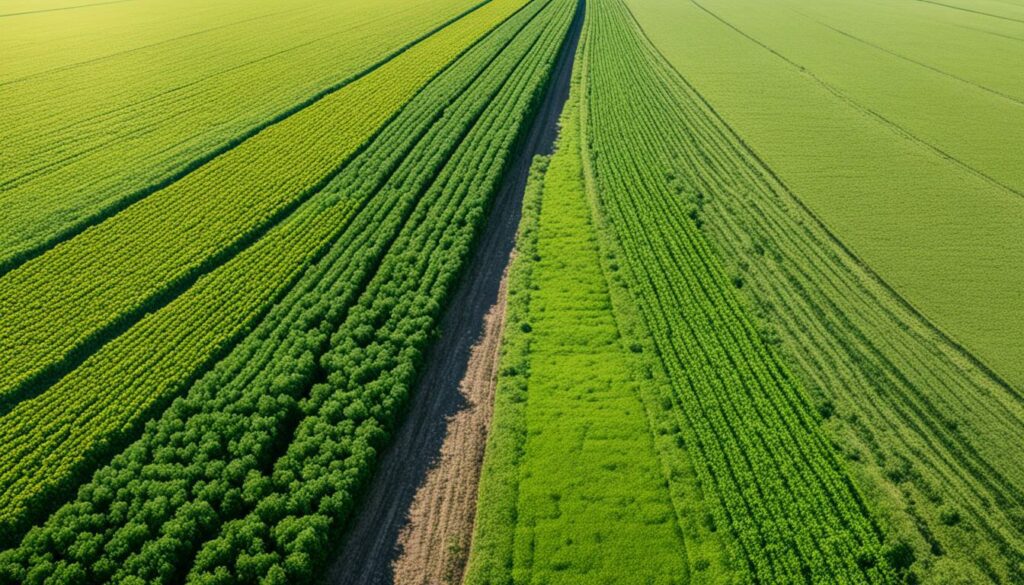
There’s a clash between wanting to protect local farmers from global competition and wanting to open up markets. The UK is slowly cutting down on the money it gives to farmers. This makes it hard to keep taking good care of the environment. Brexit has also meant a new focus on what UK farming should aim for.
The UK wants to be greener by 2030 with better environmental standards. But, there are worries about trading with the EU because of different rules. Businesses are finding it hard to keep up with all the changing regulations.
The UK is thinking about its own rules on water and air quality. These rules might not be as strong as the EU’s, which are set on keeping rivers clean and reducing harmful gases. The EU is still moving ahead with strict rules on certain products and waste. This makes it clear that the UK needs to make its own strong rules for farming and the environment.
The table below outlines how the EU and UK are taking different paths on environmental regulations:
| Policy Area | EU Regulations | UK Approach |
|---|---|---|
| Pesticide Bans | 36 harmful pesticides banned | No bans implemented |
| Carbon Pricing | Active implementation | Lagging behind |
| Water Quality | Strict pollution control | Potential regression |
| CO2 Tariffs | Immediate application | Starting 2027 at earliest |
| Battery Regulations | Established recycling measures | In consultation phase |
| Air Quality | Tightening legal constraints | Proposed loosening |
When we look at EU farming policies vs UK post Brexit, we see big differences. These are mainly in rules about the environment and the effects on money. In the EU, the Common Agricultural Policy (CAP) used to take a big part of their budget. But now, it’s not as much. The UK faces EU rivals who get bigger subsidies under the CAP. At the same time, the UK is moving to spend less on farming help and more on taking care of the land. This means UK farmers will get less money from the government than they used to under the CAP.
The rules for farming in the EU and the UK after Brexit are very different. The EU has a system that tries to make sure everyone follows the same rules. The UK is aiming for rules that are not too hard for farmers to follow. Each part of the UK is also doing things in its own way. For example, England and Wales are stopping direct payments faster than Scotland and Northern Ireland. Scotland focuses on making good food while protecting the environment. Northern Ireland is less focused on the environment but is following EU rules because of the Brexit Protocol.
After Brexit, the way money moves between the UK and the EU has changed a lot. The money the UK makes from selling farming and food products to the EU has gone down. This shows the challenge of finding new ways to trade. The UK was already buying more food than it sells before Brexit. With half its food now coming from abroad, changes in farming support could make this harder.
A compelling look at the differences is here:
| Comparison Metric | EU (CAP) | UK Post-Brexit |
|---|---|---|
| Budget Allocation | 36% of EU Budget | Declining Support Budget |
| Environmental Payments | High Under CAP | Lower Under ELMS |
| Policy Focus | Uniform Compliance | Devolved and Dynamic Alignment |
| Export Values | Steady | Substantial Decrease |
| Food Production | High Self-Sufficiency | 50% Domestic Production |
The different rules between Northern Ireland and the rest of the UK show a clear change. Even though it brings challenges, this could lead to new ways of farming that are good for the environment. As time goes on, it will be key for the UK to manage these changes well. This means finding ways to be strong economically and to care for the environment in the days after Brexit.
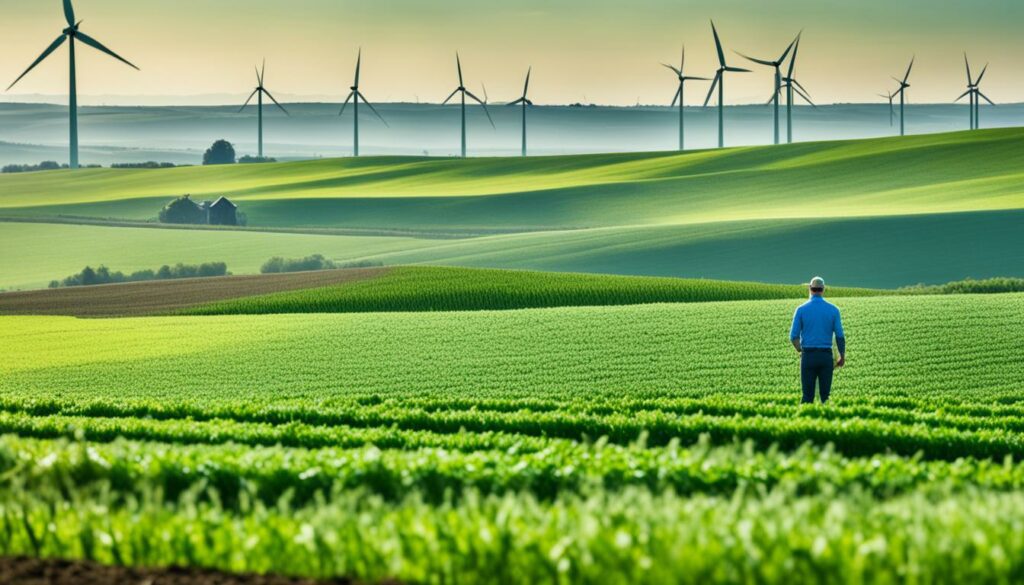
Since leaving the EU, the UK is focusing on making agriculture more green. The government aims to produce 60% of food locally. This move is about becoming more self-reliant and caring for the environment.
Before Brexit, big landowners got most of the agriculture money. Now, farming efforts aim to be fairer and better for the planet.
The Sustainable Farming Incentive and Countryside Stewardship schemes are doing well. Their value has gone up by 10%. This shows a strong commitment to better farming practices after Brexit.
Farmers are being paid extra to use green methods. For example, they get money to set up safe places for birds. They also receive funds to link rivers with their surrounding areas.
About 50 new ways to help farmers have been started. These include planting more trees and using advanced technology. The aim is to make these changes last, helping nature for years to come.
Many farmers are keen on these new plans. Around 8,000 signed up for the Sustainable Farming Incentive in 2023. There’s been a big increase in the Countryside Stewardship since 2020. This shows the UK is moving in the right green direction.
In 2023, the UK put over £168 million into farming innovation. It also invested £45 million in new farming machines and research. This money shows the UK is serious about improving farming with technology.
Since January 1, 2021, the UK has been helping farmers switch to sustainable ways in three big steps. This will go on until 2027. The goal is to slowly move to farming that’s good for nature and people.
A lot of focus is on making farmland and views better, too. The government also wants to save 30% of the land for nature by 2030. This is done through the Nature Recovery Network.
There are also grants to lower farming costs and make more profit. Programs help older farmers leave and new ones start fresh. These steps work together. They help create a farming future after Brexit that’s both green and successful.
Since Brexit, UK farming has seen big changes. These changes are mainly due to new technology. The Agri-Tech Centres, set up in 2016, have played a key role. They’ve helped with more than 500 projects linking over 350 businesses. From small startups to big companies, these efforts show the industry is serious about improving after Brexit.
Barclays is one of the leaders, offering a £250m fund for Agri-Tech. This fund is focused on making UK farming carbon net zero. It supports projects like rainwater collection and using more renewable energy. These steps help tackle climate change, fight diseases, and keep the environment healthy.
The Eagle Lab Farm at the University of Lincoln is a great example. It shows how new tech in farming can help young business owners. This project gives them access to the latest tools and contacts. Having the Agri-Tech Centres involved has made these efforts even more powerful. They are working to make the industry more united and creative.
| Project | Objective | Impact |
|---|---|---|
| CIEL | Improve livestock production | Increased efficiency and sustainability in livestock farming |
| CHAP | Promote crop health and protection | Better disease mitigation and crop resilience |
| Agri-EPI | Advance precision engineering | Enhanced productivity and reduced environmental impact |
| Eagle Lab Farm | Encourage digital transformations | Boosted technological adoption and innovation in farming practices |
These examples show how investing in agritech can bring real changes. Working together is making solutions happen faster. Looking ahead, investing in farm tech will keep UK agriculture at its best. It will help farming stay strong and protect the environment well.
After Brexit, the UK’s farming sector’s support is changing. Historic subsidies for owning and using land are being replaced. Now, the focus is on protecting the environment. This shift comes as the UK aims to achieve net zero carbon emissions by 2050. This is pushing farmers and land managers to act with the help of new schemes.
The Agricultural Transition Plan will guide the sector from 2021 to 2024. It includes schemes like the Sustainable Farming Incentive and Countryside Stewardship. These schemes support both productivity and environmental protection. It’s crucial for farmers to use this support to adopt sustainable practices.
Even though cross compliance ends in 2023, new subsidies will soften the blow. They will pay for activities benefitting wildlife and restoring habitats. The UK’s goal is to renew 30% of its natural area by 2030. This strategic shift is expected to create jobs in eco-focused sectors. It is in line with the Farming and Countryside Programme’s objectives.
A working group is ensuring this transition is fair to all. They want financial institutions to follow just transition principles and support the change. The idea is to balance economic growth with protecting the environment. The UK is working towards a sustainable future for its farmers through these efforts.
The UK’s agri-environment policies shifted towards sustainability. They now focus more on protecting nature, being carbon neutral, and promoting green farming methods.
Brexit brought about some initial money worries and the pound’s value changed. The UK government promised to keep farm funding like the CAP’s until 2020.
They also introduced new policies. These reward farmers for taking care of the environment and preventing floods.
Before Brexit, the CAP aimed to increase food production. It also managed how unstable markets affected farmers.
However, it sometimes didn’t help smaller farms enough. After leaving the EU, the UK is changing to support greener outcomes and sustainable farming better.
Since Brexit, the UK has its own farming rules that match local goals better. There’s less red tape and a big push for voluntary schemes that help nature and people.
The 25 Year Plan aims for more thriving wildlife and cleaner air and water. It also wants to fight climate change.
Farms are encouraged to improve soil health, water use, and wildlife habitats, creating benefits for everyone.
The Foundation Scheme encourages farmers to join in voluntarily. It’s all about helping the environment stand out.
This scheme makes rules easier to follow. It also includes yearly payments, especially for farmers in tougher areas.
The Farmer Cluster Scheme is about teamwork in looking after nature. A coordinator helps manage shared areas.
Farmers sign up for ten-year deals. These can be paused after five years. It’s all about smart ways to protect the environment.
Brexit brings both challenges and chances for the countryside. There’s worry over less help.
Yet, new rules and efforts promise to boost nature, make landscapes stronger, and farm greener.
Post-Brexit, UK rules seek a balance between being firm and practical. The focus is on caring for the environment and staying green.
UK is also working on unique trade deals. It puts British farm ways first, especially eco-friendly farming.
After Brexit, the UK is keener on farming methods that help nature. This includes farmer clusters looking after the land together.
Green stewardship is also key in any new trade deals. Protecting wildlife, soil, and water are now measures of farming success.
Innovations like Agritech are helping to update UK farming. Big money goes into digital tools, green energy, and varied crops.
The idea is to make the farming industry ready for the future and to cut carbon emissions.
Post-Brexit, UK farmers are getting support in various ways. For now, there’s money from CAP up to 2020, along with new rural and green schemes.